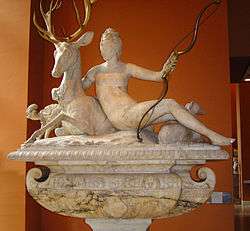Fountain of Diana
The Fountain of Diana (French: Fontaine de Diane), also known as Diana of Anet (French: Diane d'Anet) and Diana with a Stag (French: Diane au cerf), is a marble Mannerist sculpture of the goddess Diana, representing Diane de Poitiers. It was created c. 1549 to be the central ornament of a grand fountain in a courtyard of Diane de Poitier's Château d'Anet, but today is in the Louvre, Room 15b on the ground floor of the Richelieu Wing (Louvre inventory no. MR 1581 MR sup 123). Long believed to be the work of Jean Goujon, the identity of the sculptor is now considered uncertain, although Benvenuto Cellini, Germain Pilon, Pierre Bontemps, and Ponce Jacquiot have in turn been suggested.

Description
Diana, the goddess of hunting, is represented with two dogs (a greyhound named Phrocyon and a barbet dog named Cyrius) and a large stag. This striking ensemble has become one of the most famous works of the French Renaissance. Not a true portrait of Diane de Poitiers,[1] it is but one of the many closely related images of moon goddesses, including the paintings Diana the Huntress by a member of the School of Fontainebleau and Le Bain de Diane by François Clouet.
The sculpture was a part of the fountain in Diane de Poitiers's Château d'Anet built by Philibert de L'Orme. The ensemble, as engraved in its original location by Jacques Androuet du Cerceau and as shown in a 16th-century drawing at the Louvre, differs from its current form. The stag's head and the dog on the left are positioned quite differently.[2] The sculpture was heavily restored in the 18th century and a second time in 1799-1800 by Pierre-Nicolas Beauvallet.[1] Nevertheless, an early 17th-century unpublished drawing by Jacques Gentilhâtre in the Library of the Royal Institute of British Architects shows it much as seen today. In 1953, the British art historian Anthony Blunt argued that the engraving and the earlier drawing are not independent, and the differences are the result of "the sort of alteration that du Cerceau often made."[2]
The traditional attribution to Jean Goujon, suggested by Alexandre Lenoir in 18th century, is not accepted today. Others have been suggested, including Benvenuto Cellini, Pierre Bontemps, Ponce Jacquiot and especially Germain Pilon.[1][3]
- Drawings related to the Fountain of Diana
.jpg) Engraving published by Jacques Androuet du Cerceau in 1579
Engraving published by Jacques Androuet du Cerceau in 1579.jpg)
Notes
- "Fountain of Diana", Louvre website.
- Blunt 1953, p. 249, note 125. Blunt mentions that the drawing is reproduced in Mayer 1939, p. 129.
- For Germain Pilon, see Blunt, Anthony; Beresford, Richard (1999). Art and Architecture in France, 1500–1700, 5th edition, pp. 80–81. New Haven, Connecticut: Yale University Press. ISBN 9780300077483
- Reproduced in Mayer 1935, p. 129.
Bibliography
- Beaulieu, Michèle, "Description raisonnée des sculptures du Musée du Louvre", vol. 2, Renaissance française, Paris, 1978, pp. 96-99.
- Blunt, Anthony, Art and Architecture in France 1500-1700, London, 1953, p. 70. (French edition, 1983, p. 108.)
- Du Colombier, P., Jean Goujon, Paris, 1949, pp. 130-133.
- Mayer, Marcel, "La fontaine de Diane du château d'Anet n'est pas de Benvenuto Cellini", Revue de l'art ancien et moderne, vol. 68, June 1935, pp. 125-134.
- Zerner, H., L'Art de la Renaissance en France. L'invention du classicisme, Paris, 1996, pp. 361-363.